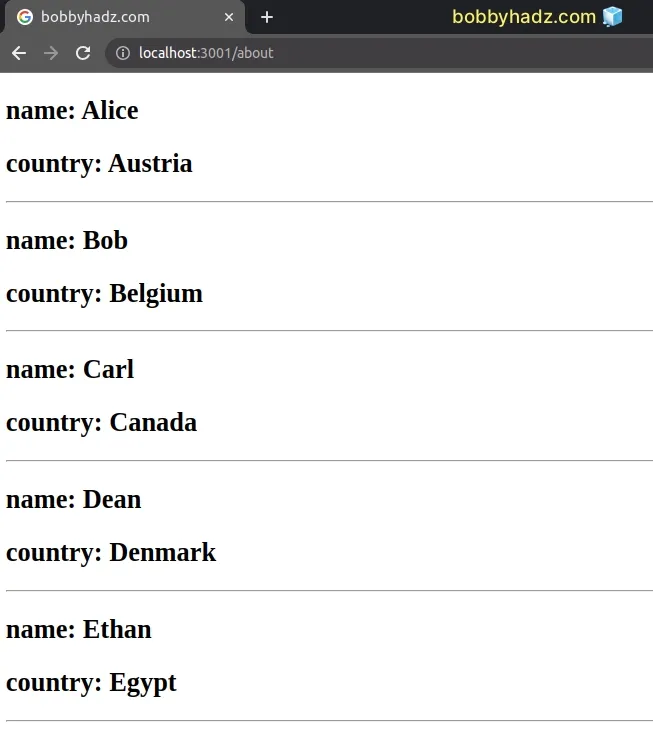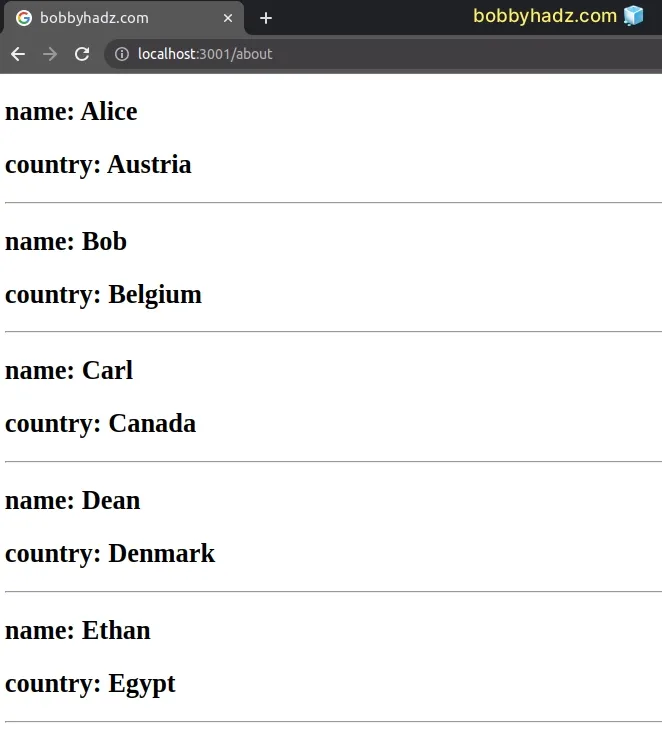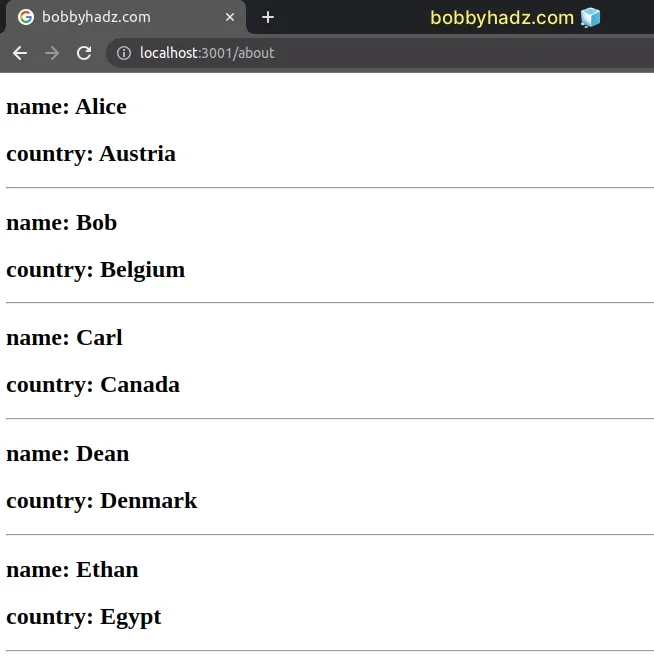Loop through an Array of Objects in React
Last updated: Apr 6, 2024
Reading time·3 min

# Loop through an Array of Objects in React
To loop through an array of objects in React:
- Use the
map()method to iterate over the array. - The function you pass to
map()gets called for each element in the array. - The method returns a new array with the results of the passed-in function.
export default function App() { const employees = [ {id: 1, name: 'Alice', country: 'Austria'}, {id: 2, name: 'Bob', country: 'Belgium'}, {id: 3, name: 'Carl', country: 'Canada'}, {id: 4, name: 'Dean', country: 'Denmark'}, {id: 5, name: 'Ethan', country: 'Egypt'}, ]; return ( <div> {employees.map(employee => { return ( <div key={employee.id}> <h2>name: {employee.name}</h2> <h2>country: {employee.country}</h2> <hr /> </div> ); })} </div> ); }

The function we passed to the Array.map() method gets called for each element in the array.
On each iteration, we set the key prop on the outermost element to a unique
value, and rendered the values of the object.
Setting the key prop to a unique value is important, otherwise, you'd get the
Encountered two children with the same key
warning.
# Destructuring the object's properties
You can also destructure the object's properties to make your code a little easier to read.
export default function App() { const employees = [ {id: 1, name: 'Alice', country: 'Austria'}, {id: 2, name: 'Bob', country: 'Belgium'}, {id: 3, name: 'Carl', country: 'Canada'}, {id: 4, name: 'Dean', country: 'Denmark'}, {id: 5, name: 'Ethan', country: 'Egypt'}, ]; return ( <div> {employees.map(({id, name, country}) => { return ( <div key={id}> <h2>name: {name}</h2> <h2>country: {country}</h2> <hr /> </div> ); })} </div> ); }
We destructured the parameters of the object parameter, so we don't have to access each property on the object.
Note that you shouldn't try to access the key property, otherwise, the warning
Key is not a prop. Trying to access it will result in undefined
is raised.
Alternatively, you can use the Array.forEach method.
# Loop through an Array of Objects using forEach()
This is a three-step process:
- Use the
forEach()method to iterate over the array. - Declare an empty array that will store the JSX elements.
- On each iteration, push the JSX for the object into the array.
export default function App() { const employees = [ {id: 1, name: 'Alice', country: 'Austria'}, {id: 2, name: 'Bob', country: 'Belgium'}, {id: 3, name: 'Carl', country: 'Canada'}, {id: 4, name: 'Dean', country: 'Denmark'}, {id: 5, name: 'Ethan', country: 'Egypt'}, ]; const results = []; employees.forEach(employee => { results.push( <div key={employee.id}> <h2>name: {employee.name}</h2> <h2>country: {employee.country}</h2> <hr /> </div>, ); }); return ( <div> {results} </div> ); }

This example achieves the same result.
forEach() method gets called with each element (object) in the array.Instead of directly rendering the object's values, we push the JSX markup for
each object into a results array.
The last step is to render the array of results.
If you need to filter an array of objects in React, click on the following article.
# Loop through an Array of Objects using for...of
You can also loop through an array of objects using the for...of loop.
export default function App() { const employees = [ {id: 1, name: 'Alice', country: 'Austria'}, {id: 2, name: 'Bob', country: 'Belgium'}, {id: 3, name: 'Carl', country: 'Canada'}, {id: 4, name: 'Dean', country: 'Denmark'}, {id: 5, name: 'Ethan', country: 'Egypt'}, ]; const results = []; for (const employee of employees) { results.push( <div key={employee.id}> <h2>name: {employee.name}</h2> <h2>country: {employee.country}</h2> <hr /> </div>, ); } return ( <div> {results} </div> ); }

The for...of loop can also be used to iterate over an array of objects.
for...of instead of the forEach() method when you have to use the break keyword to exit out of a loop prematurely.The break keyword cannot be used in the forEach() method, but it is
supported in the for...of loop.
I've also written an article on:
If you need to loop through an object, click on the link and follow the instructions.

